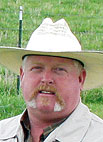
At the ripe old age of 9, Scott Bass already had the heart of a cattleman. He mowed yards and earned enough money to buy his first two calves from his grandpa for $100 each. Scott said, “The best thing you can do is teach a kid the value of a dollar.”
A picture of those two Hereford calves hangs in his office at Bass Livestock Nutrition, LLC near Rogersville, Mo., in Webster County.
He now has around 750 head of cattle on his 400-acre farm near Rogersville. Some of the land has been in the family over 100 years. He also leases another 1,600 acres for pasture and hay.
Scott said, “Our cattle business consists of a cow/calf operation. Then we background some of our steers and we have a small finish yard where we feed out calves to sale for butchering. We retain most of our replacement heifers. We market some feeder cattle. The cattle that don’t go into either of those segments end up as feeder cattle that we sell.”
The cow/calf beef operation is the commercial side. Scott added, “I have a small herd of registered Herefords and a small herd of registered Angus that we use for our genetics for our commercial beef cattle. So we kind of do everything ‘in house.’ We try to raise our own bulls and we have extra bulls that we sell. We’ve kind of got a beef production side and then a genetic production side.
“In a nutshell, we have the Angus seedstock herd and the Hereford seedstock herd and we use that for our genetics and our commercial beef herd,” he stated. “Angus have sold really well, and still do. But the demand for Hereford genetics is probably better right now than it’s been in a long time. I have always had some Herefords. But we haven’t been in the Hereford genetics business very long.”
He explained, “About five or six years ago, when the inputs got really high, things kind of took off. Things were different and Herefords and Angus have always been real efficient. I’m not knocking any other breed of cattle. They’re all good and have good points, but the Black Baldy is efficient. They go out and take the forage available and turn it into beef. I think that’s one reason why Herefords now are making a little bit of resurgence, because they can do that.”
His seedstock is registered. The commercial are not. A lot of his cows are black, black baldy and red baldy.
Scott said, “When I get a phone call for a potential bull sale, right now I have more inquiries about Hereford than I do Angus. The Angus and Hereford genetics together make a great combination.”
Genetics is the side of the cattle business that Scott really enjoys. He explained, “That’s the kind of cattle that someday you can leave for a future generation to build on.”
Scott stated, “The commercial cow is going to produce beef and do her job. When she’s done, she goes on. But if a person can build a good genetic base, he’s got genetics he can pass on to the future. I’m using genetics now that guys developed in the 1940s.” That has a big influence on his Herefords now.
Everything started with the farm. Then when Scott’s dad, Gene, retired they started Bass Livestock Nutrition, LLC. (BLN). They became a distributor of Vita Ferm mineral. BLN covers, “approximately a 200 mile radius of Springfield, Mo., in the four state area; Arkansas, Kansas, Missouri and Oklahoma, and we deliver,” Scott said.
They have also developed their own products. He said, “We developed Vita Tub, which is a cooked molasses based tub. Our background of being in the cattle business and using these products with our own cattle helps us.” They also have their own line of livestock cattle supplements called BLN.
Scott does mix some feed for his cattle since they grow most of it. But he said, We don’t make it to sell.” He explained, “You get into a whole different world; miller’s insurance, liability, just a whole different world when you start mixing feed and grinding to sell to the public.”
When it comes to buying minerals, Scott stated, “I try to see what my animal needs and then see what is available to match that. In our part of the country we’re magnesium deficient. So I try to buy, or sell, a product with magnesium in it and less protein, because you don’t need all the protein when the grass is lush.”
He advised, “Match your supplement with what you need. There’s no sense feeding something you don’t need. If you’re feeding high protein hay and grass, there’s no reason to buy a product that has extra protein.”
Bass Premium Beef, LLC., is another company Scott and his dad are partners in. He explained, “I have things broke up into entities. His farm sells the calves to Bass Premium Beef and they deal with the customers.” By separating things, Scott is able to assess whether a business is pulling its weight. He said, “It’s a good breakdown.”
When a local feed store closed, Scott thought it would be nice to fill that void. His first partner in that venture retired and Marcie Ballard bought his part. Scott called it “the perfect fit.” Today Marcie runs the day-to-day operation at Bass and Ballard Feed and Farm Supply about one mile east of Rogersville.
“When we acquired one of the warehouses we had a lot of empty space,” Scott stated. He added, “We needed the building but couldn’t fill it. So dad and I talked about getting in the pet food business. We’re partners in the business, but dad handles the pet food.”
Scott Bass has several irons in the fire, but the thing he most enjoys is being with the cattle. He also feels blessed to be part of a “tight-knit family operation.”







